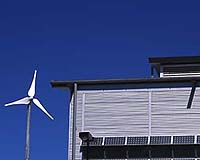 |
Washington DC (SPX) Jan 26, 2010 Today's farmers are interested in wind energy because they're good managers; farming is all about maximizing profits and reducing risk. Wind energy does both. It's an additional, steady source of income that doesn't require extra work, a second crop that can be harvested without effort or significant use of land. Some people might believe because wind turbines are such large structures that they take substantial acres of property out of production. This is a common misconception. In reality, wind turbines occupy a small area, leaving 99% of farmland in production. A rule of thumb regarding wind farm land use is that, while each turbine generally needs a plot of about 100 acres separating it from other turbines, the actual footprint of each turbine is less than one acre. This footprint includes the area surrounding the turbine and all access roads. Therefore, each turbine occupies less than 1% of the open land required by a wind farm, leaving the other 99% of the property available as farmland or pasture. To examine the impact wind energy can make on a small amount of land, let's envision a hypothetical farmer, John, who grows corn on 500 acres of land. According to the 2008 Riverland Community College Farm Business Management Annual Report for Southeast Minnesota, the average return per acre of corn from 1999-2008 was $60.13 per acre. A total of 500 acres of corn at $60.13 profit equals $30,065 per year. This is the farmer's return on labor and management after investing capital, labor, management and taking commodity and weather risks. Now, imagine that John has five turbines on his farm, occupying five of his cropping acres, leaving him with 495 acres of corn. His farming conditions are the same, so from those acres he'll make $29,764 in profit, based on the 10 year average profit of $60.13 per acre. But add in the revenue from the turbines--$35,000 total assuming $7,000 per turbine (on the low end of what National Wind pays)--and his total profits increase to $64,764 per year. This would be almost double his profits from growing only corn without turbines. Under National Wind's community model, the profit structure may be even better if landowners take an ownership stake in a project company and share in the actual profits generated. What if there is heavy flooding or drought next summer, and John is only able to harvest a fraction of expected yield? His revenue could drop to a level below his expenses. Maybe he would break even with the help of crop insurance, but he won't see a cent of profit. If he had turbines on his property, he would still earn $35,000 in profits. Turbine revenues help to buffer against these acts of God and resulting price volatilities. This allows the farmer to diversify his income and reduce risk. Wind is another crop that more and more farmers are harvesting. With a small initial outlay of land, a turbine can continue to provide income for years into the future. After construction is complete, the practice of farming continues as it has for generations, with the bonus of added financial security.
Related Links National Wind Wind Energy News at Wind Daily
 British engineers slam home wind turbines as 'eco-bling'
British engineers slam home wind turbines as 'eco-bling'London (AFP) Jan 20, 2010 Installing wind turbines and solar panels in people's homes is "eco-bling" that will not help meet Britain's targets on cutting carbon emissions, engineers warned Wednesday. In a new report by the Royal Academy of Engineering (RAE), Professor Doug King said it was better to adapt buildings to make them more energy efficient than try to offset energy use with "on-site renewable energy generat ... read more |
|
| The content herein, unless otherwise known to be public domain, are Copyright 1995-2009 - SpaceDaily. AFP and UPI Wire Stories are copyright Agence France-Presse and United Press International. ESA Portal Reports are copyright European Space Agency. All NASA sourced material is public domain. Additional copyrights may apply in whole or part to other bona fide parties. Advertising does not imply endorsement,agreement or approval of any opinions, statements or information provided by SpaceDaily on any Web page published or hosted by SpaceDaily. Privacy Statement |